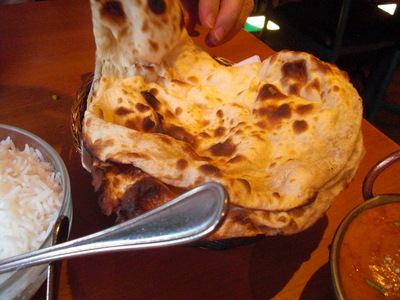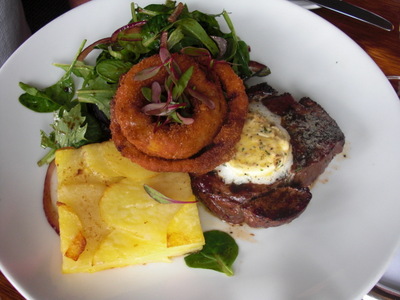
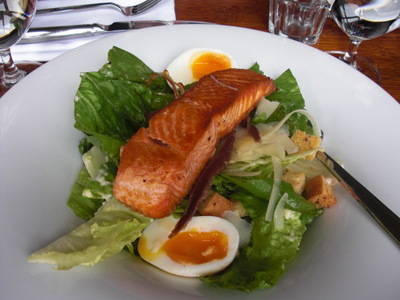 Andrew was starving, having missed a couple of meals in transit over the Pacific, so he ordered and very much enjoyed this steak, topped with a disk of melting herbed butter and accompanied by salad, onion rings, and a gratin of potatoes.
Andrew was starving, having missed a couple of meals in transit over the Pacific, so he ordered and very much enjoyed this steak, topped with a disk of melting herbed butter and accompanied by salad, onion rings, and a gratin of potatoes.Wednesday, 5 December 2012: Wellington, Te Papa
The weather forcast had been for rain all week, and on Wednesday, the showers finally arrived, driven sideways by tropical-storm-force winds, and the temperature hovered around 60°F. I was behind on my blog notes and photo triage (too much time doing stuff and not enough writing about it), so I judged it a good day to stay indoors. I accordingly hung out at meeting headquarters, writing and using the wi-fi, until lunch time. Just before the meeting was dismissed (Wednesday afternoon was left free for tourism), as Intellicast had predicted, the skies opened and it poured, still horizontally. We had an excellent lunch at the St. John's Heineken Hotel, in their restaurant "In Vivo," with originally British colleague Andrew Sweetman, who spent some time in David's lab when he was an undergraduate and now lives and works in Norway. Andrew had spotted the restaurant earlier, in a direction I hadn't gone yet, and it was much closer than anything I knew of—important in that weather!

 Andrew was starving, having missed a couple of meals in transit over the Pacific, so he ordered and very much enjoyed this steak, topped with a disk of melting herbed butter and accompanied by salad, onion rings, and a gratin of potatoes.
Andrew was starving, having missed a couple of meals in transit over the Pacific, so he ordered and very much enjoyed this steak, topped with a disk of melting herbed butter and accompanied by salad, onion rings, and a gratin of potatoes.
I had a Caesar salad, with anchovies (I was given the choice), topped by a slab of outstandingly succulent grilled salmon. Note the not-quite-hard-cooked eggs. Excellent!
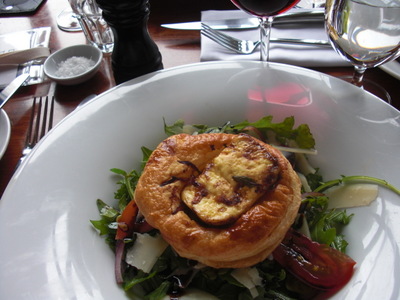
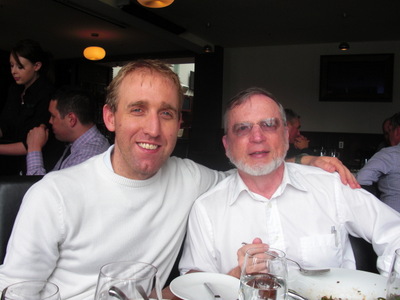 David ordered this slab of halloumi cheese roasted atop a pastry disk and served on a different salad. Very nice lunch altogether.
David ordered this slab of halloumi cheese roasted atop a pastry disk and served on a different salad. Very nice lunch altogether.
But then it was decision time. The original plan had been to play golf with Andrew on Wednesday afternoon. I had lugged along a special change of clothes, just for the occasion, but given the meteorological conditions, I was dubious. When I play golf in the rain, I generally just wear cotton and plan on getting wet, but that's in Tallahassee, at 80 or 90°F. David, on the other hand, has (and had brought along) an entire set of waterproofs, which he uses on shipboard, and Andrew was, like, "What? We play in weather like this all the time in Bergen." It didn't sound like fun to me, and my sinuses were already giving me fits, so I begged off, but they suited up and set out in a taxi, in search of a course. I consigned my dripping hat and coat to the checkroom in the Te Papa lobby and set out to explore the museum's collections.
The ground floor of the museum is mostly taken up with the gift shop, cafeteria, coat check, etc., so you start by riding the escalators to the second floor, where, once past the reception desk (no ticket office—it's all free of charge), about the first thing you encounter is a full-size set of the three trolls from The Hobbit, supplied by the Weta Workshop, which crafted them (both for the movie and for the museum). A small sign tells you which one is Tom, which one is Bert, etc., and one of them stands with his foot raised high, at the ready to step on a hobbit. Families were taking turns posing their small children in front of the display, so as to look like they were under that foot.
Beyond that was the museum's holiday gingerbread house, constructed on the second day of the meeting from panels of real gingerbread freshly prepared by the museum's staff of chefs (as a major meeting venue and event center, it employs a large and excellent staff of chefs). The panels were bolted to a wooden framework, and chefs with large pastry bags stood by to frost over each bolt as it was placed, then to decorate the result. The house was large enough for small children to go inside, but no one was allowed to. It smelled delicious for the rest of the week, to a distance of several yards.
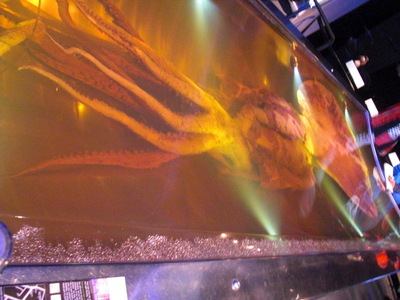
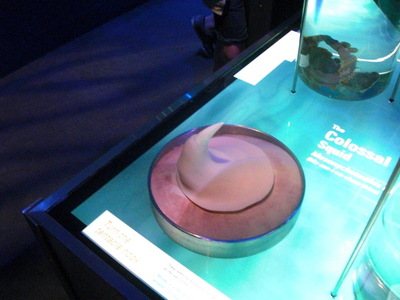 Beyond thatwas one of the museum's star attractions, its colossal squid, the only one on public display in the world. The colossal is a different species from the giant squid, like the one on display at Mote Marine Lab. It's not as long, but it's much more massive and is therefore, by that measure, the largest known. In 2007, a New Zealand fishing vessel was longlining in the Antarctic for toothfish and happened to have a documentary film crew aboard. Meanwhile, down below, a collossal squid had come across one of its hooked toothfish, grabbed on and started munching. When the line was winched back in, the squid, for some reason, refused to let go, and when it broke the surface, everybody's jaw dropped and they hollered for the cameras. As a result, they have film (showing as a continuous loop at the museum) of the capture of the squid, still alive, chewing on the fish. Surprisingly (to me, at least), it was bright candy-apple red. They gaffed it so that it couldn't get away, then spent a long time maneuvering a large net under and around it so that they could hoist it aboard. Having no other way to preserve it, they folded it into a large crate, froze it, brought it home, and presented it to the museum.
Beyond thatwas one of the museum's star attractions, its colossal squid, the only one on public display in the world. The colossal is a different species from the giant squid, like the one on display at Mote Marine Lab. It's not as long, but it's much more massive and is therefore, by that measure, the largest known. In 2007, a New Zealand fishing vessel was longlining in the Antarctic for toothfish and happened to have a documentary film crew aboard. Meanwhile, down below, a collossal squid had come across one of its hooked toothfish, grabbed on and started munching. When the line was winched back in, the squid, for some reason, refused to let go, and when it broke the surface, everybody's jaw dropped and they hollered for the cameras. As a result, they have film (showing as a continuous loop at the museum) of the capture of the squid, still alive, chewing on the fish. Surprisingly (to me, at least), it was bright candy-apple red. They gaffed it so that it couldn't get away, then spent a long time maneuvering a large net under and around it so that they could hoist it aboard. Having no other way to preserve it, they folded it into a large crate, froze it, brought it home, and presented it to the museum.
Scientists at the museum devoted a lot of thought to how to thaw it with the least damage and ended up soaking it for weeks in ice-cold seawater, to thaw it evenly, all the way to the center. Then they studied it in the "fresh" state for as long as they dared before beginning the equally long process of injecting it with and soaking it in formalin to preserve. it. Now it lies (photo on the left) in a specially built glass-topped case, floating in preservative, and it's really impressive, even though part of the color has faded and its skin is ragged and peeling. It weighed 495 kg when fresh. Its eyes are the size of soccer balls, its beak as large as my two hands, and its two long catch tentacles are armed with curved hooks (photo at right) as large as my thumbs, set in special bases that allow them to swivel almost 360 degrees.
Besides the video and static exhibits, the museum provides a very impressive computer animation of the animal in (hypothesized) action, catching fish and dodging a sperm whale (its only known predator).
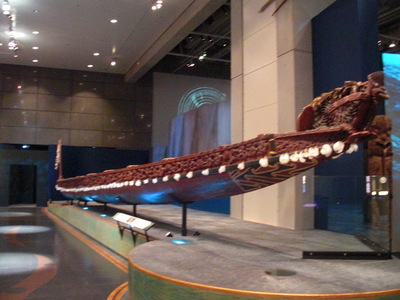
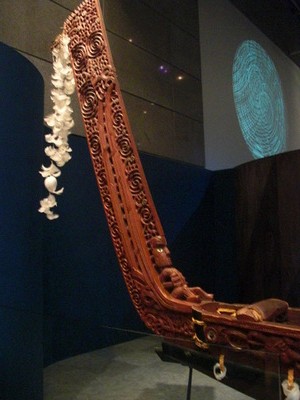 In the section on Maori culture, I got these shots of a dugout canoe. It's much smaller than the one we saw in Auckland but has the virtue of being small enough that, by photographing it lengthwise, I could at least get all of it into the frame. I think the white decorations are tui feathers, from the two white tufts on the chest, though some of those tuis must have been impressively big.
In the section on Maori culture, I got these shots of a dugout canoe. It's much smaller than the one we saw in Auckland but has the virtue of being small enough that, by photographing it lengthwise, I could at least get all of it into the frame. I think the white decorations are tui feathers, from the two white tufts on the chest, though some of those tuis must have been impressively big.
The museum also has an "earthquake house," a small house you can enter and experience what an earthquake would feel like. I found it less impressive than the one in the museum of Auckland, which purported to convey the experience of having one of the city's many quiescent volcanoes erupt. It showed simulated video of a volcanic cone rising right out of the harbor and of the tidal wave sweeping ashore, up the slope, and eventually over the camera. Apparently such an eruption is considered a definite if not imminent possibility, and the simulated news reports (apparently featuring real local news commentators) emphasized the chaos along evacuation routes caused by those who didn't leave the city promptly at the first signs of volcanic rumblings (e.g., smoke and steam being to rise from the center or the harbor.
Another fun feature, although a little too Disney for my taste, was the "junk shop that comes alive." It's apparently very popular and has limited seating, but it was a slow day at the museum, so I got in with no delay. The small audience sits inside what purports to be a junk shop, looking out through the front window, where they hear the departing proprietor lock up and then appear before the window to close the shutters for the night. When all is quiet, the shutters open again to show scenes from local history, as items in the junk shop—those involved in the scenes being shown—light up, move, or otherwise draw attention to themselves. Very interesting videos, but I found the audioanimatronic junk superfluous.
Eventually, David and Andrew straggled back, having gotten in their nine holes. David said the course had no bunkers or water hazards and didn't need them. It was incredibly steep, the water was falling from the sky (although not continuously, he said), and the wind was so fierce that they had not only to allow for windage while putting but to swing quickly on their drives, before the ball blew off the tee.
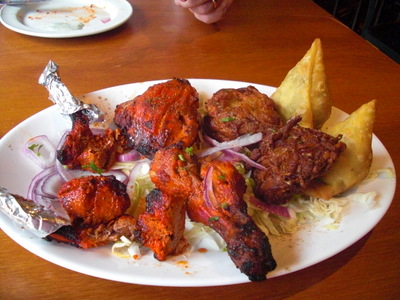
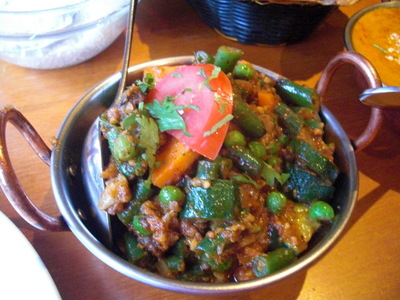 David expressed himself willing to go for something a little spicier, so tried a restaurant called Little India. As usual, in trying a new Indian restaurant, we found no combination more appealing than the set "dinner for two" on the menu.
David expressed himself willing to go for something a little spicier, so tried a restaurant called Little India. As usual, in trying a new Indian restaurant, we found no combination more appealing than the set "dinner for two" on the menu.
First course: Tandoori chicken, tandoori lamb, onion bhaji, and vegetable samosas.
Vegetables: Mixed vegetables in a spicy curry sauce.
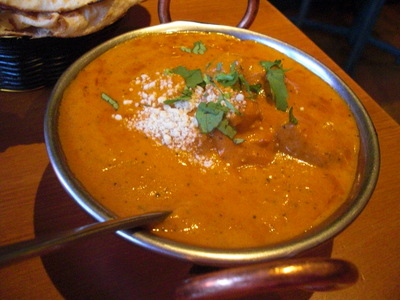
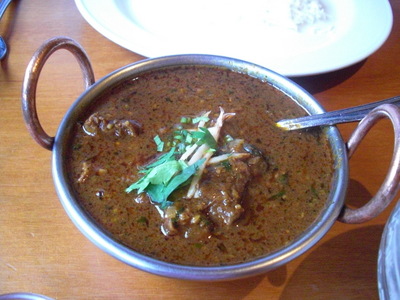 Main course 1: Chicken mumtaz, chicken in a creamy sauce.
Main course 1: Chicken mumtaz, chicken in a creamy sauce.
